#no man's sky multiplayer
Text
#no man's sky#nms#hyperspecific poll#specific poll#I haven't even gotten to where I'm *able* to use an exocraft lmao#and I always turn multiplayer off unless playing with someone specific. The Anomaly being full of People fills me with Terror
37 notes
·
View notes
Photo





No Mans Sky
#no mans sky#nms#game#games#videogames#spiele#videospiele#pc games#ps4 games#multiplayer#space#science fiction#sci fi#space sims#space games#structures#forms#deutsche blogs#germany#deutschland#screenshots#game photography
1 note
·
View note
Text
The Subnautica of other fears
Subnautica is a game infamous for it's almost all ocean planet, underwater worldbuilding, and deep sea gameplay. It's also the bane of all thalassaphobia peeps.
So here's the subnautica of other phobias
Claustrophobia Fear of Tight/Cramped Spaces - The Forest Series : After a plane crash leaves you stranded in a strange forests, something increasingly becomes... wrong. The caves around don't help.
Scopophobia Fear of being watched or the center of attention - Brighter Day : A weirdcore horror game where something is definitely watching you and definitely following you.
Entomophobia/Arachnophobia - Grounded : You play a group of kids who are stuck in a "honey I shrunk the kids" incident. They are forced to venture across their yard, and survive the various common insects around.
Megalophobia Fear of very very very big things - The Utility Room : An experience. More of an experience then a game and fever dreamish, worth it, and mysterious all the way. It's almost as if the universe accidentally left one strange dev room behind.
Nyctophobia Fear of darkness - Amnesia: The Bunker (from the Amnesia series) : It's a first-person survival horror. You play a French man trapped in a bunker during WW1, while being hunted by something inside its darkness.
Autophobia Fear of being/feeling alone - Firewatch : You work in a national park in order to watch out for fires. Traveling across the Wyoming wilderness takes a complicated turn.
Hemophobia Fear of blood or bleeding - Iron Lung : What awaits you in the deep of a strange moon. Trapped in a submarine you have no choice but to find out.
Amaxophobia Fear of car accidents or being run over - Decimate Drive : After freeing yourself from a kidnapping, the world you wake up to is full of hostile cars.
Final Boss Games:
Lethal Company

Fun with friends :D
Genre: Indie Comedy Horror
Takes place on alien planets in outerspace
It's multiplayer, and very fun, but as soon as it hits the fan the sound design works hard to immerse you in the sudden loneliness. The games sound design is one the major players of Lethal Company's fear. As soon as a friend walks away the proximity chat teaches you just how separated you now are.
Before you know it you have had something unfriendly following behind you, and finally finding the silhouette of a friend in the dark you are betrayed by the creatures of the Lethal Company universe.
Fear of Darkness
Fear of Loneliness
Fear of Being Watched
Fear of Outerspace
The Metro Series

Genre: Survival Horror Shooter
You play the beautiful and amazing Artyom Chynornyj in the post-apocalyptic world of Metro. Developed by Ukrainians and based off the Russian book series + Polish fanon writing community.
The world of Metro is unfair and unforgiving, full of mutated creatures, and the leftover souls that the destruction of humanity left in it's wake. Crawl across the underground of Russian cities, or panic across the even more dangerous world of the destroyed above.
Fear of Darkness
Fear of Wild Animals
Fear of Deep Water
Fear of Ghost/The Supernatural
Fear of Insects/Spider
Fear of Heights
Fear of Dead Bodies
Fear of the Cold
No Man's Sky
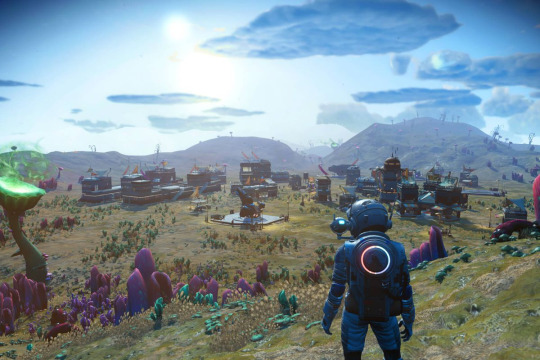
The scariest game I've ever played. I don't know why, but this game freaks me out. I know the picture I chose was harmless, but I did that on purpose.
This game is beautiful, but don't let that fool ya. This world will leave you no hesitation lost in the unpredictable randomly generated horrors of space. From planet that are all water, to colossus creatures you see for only a split second, to the infinite colorless expanse of space.
Megalphobes and astrophobes, this is your subnautica
Fear of Outerspace
Fear of Darkness
Fear of Cramped Spaces
Fear of the Unknown
Fear of Very Very Very Big Things
Fear of Deep Water
Fear of Loneliness
Fear of Caves
Fear of the Supernatural
493 notes
·
View notes
Text
it was crazy that the no mans sky people lied about multiplayer at launch and were just like Yeah there's so many planets theres no way youll find someone else. such a pimp move
3K notes
·
View notes
Text
Dragon Age: The Veilguard GameInformer Article Transcribed SPOILER-FREE
I've gone ahead and transcribed the GameInformer article about DA:TV for those who can't read it from screenshots/on GameInformer for whatever reason. This version specifically is the PLOT-SPOILER-FREE version! I've removed all references to the main storyline of the game (even those revealed in the gameplay footage already released, just to be sure) to mostly focus on mechanics and the author's general impressions of the game. It does still include some references to companions and their personalities/mechanic abilities, as well as a couple locations that we're already confirmed to be visiting. However, further details on specific locations are hidden.
As mentioned in my full version of the article, I've transcribed it as accurately as I could, which means including typos, grammar mistakes, improper capitalization, etc.
Throughout my research and preparation for a trip to BioWare’s Edmonton, Canada, office for this cover story, I kept returning to the idea that its next game, Dragon Age: The Veilguard (formerly subtitled Dreadwolf) is releasing at a critical moment for the storied developer. The previous installment, Dragon Age: Inquisition, hit PlayStation, Xbox, and PC a decade ago. It was the win BioWare needed, following the 2012 release of Mass Effect 3 with its highly controversial and (for many) disappointing ending. Inquisition launched two years later, in 2014, to rave reviews and, eventually, various Game of the Year awards, almost as if a reminder of what the studio was capable of.
Now, in 2024, coincidentally, the next Dragon Age finds itself in a similar position. BioWare attempted a soft reboot of Mass Effect with Andromeda in 2017, largely seen as a letdown among the community, and saw its first live-service multiplayer attempt in 2019’s Anthem flounder in the tricky waters of the genre; it aimed for a No Man’s Sky-like turnaround with Anthem Next, but that rework was canceled in 2021. Like its predecessor, BioWare’s next Dragon Age installment is not only a new release in a beloved franchise, but is another launch with the pressure of BioWare’s prior misses; a game fans hope will remind them the old BioWare is still alive today.
“Having been in this industry for 25 years, you see hits and misses, and it’s all about building off of those hits and learning from those misses,” BioWare general manager Gary McKay, who’s been with the studio since January 2020, tells me.
As McKay gives me a tour of the office, I can’t help but notice how much Anthem is scattered around it. More than Mass Effect, more than Dragon Age, there’s a lot of Anthem - posters, real-life replicas of its various Javelins, wallpaper, and more. Recent BioWare news stories tell of leads and longtime studio veterans laid off and others departing voluntarily. Veilguard’s development practically began with the COVID-19 pandemic in 2020. When I ask McKay about the tumultuousness of BioWare and how he, as the studio manager, makes the team feel safe in the product it’s developing, he says it’s about centering on the creative vision. “[When] we have that relentless pursuit for quality, and we have passion and people in the right roles, a lot of the other stuff you’re talking about just fades into the background.”
That’s a sentiment echoed throughout the team I speak to: Focus on what makes a BioWare game great and let Veilguard speak for itself. Though I had no expectations going in - it’s been 10 years since the last Drag Age, after all, and BioWare has been cagey about showing this game publicly - my expectations have been surpassed. This return to Thedas, the singular continent of the franchise, feels like both a warm welcome for returning fans and an impressive entry point for first-time players.
New Age, New Name
At the start of each interview, I address a dragon-sized elephant in the room with the game’s leads. What was Dragon Age: Dreadwolf is now Dragon Age: The Veilguard. Why?
“These games are reflections of the teams that make them, and as part of that, it means we learn a lot about what the heart and soul of the game really is as we’re developing it,” Veilguard game director Corinne Busche tells me. “We quickly learned and realized that the absolute beating heart of this game is these authentic, diverse companions. And when we took a step back, as we always do, we always check our decisions and make sure they still represent the game we’re trying to build.”
Dreadwolf no longer did that, but each member of BioWare I speak to tells me The Veilguard does. And while I was initially abrasive to the change - lore aside, Dreadwolf is simply a cool name - I warmed up to The Veilguard.
Solas, a Loki-esque trickster member of the Elven pantheon of gods known as the Dread Wolf, created the Veil long ago while attempting to free the elves from their slave-like status in Thedas. This Veil is a barrier between the magical Fade and Thedas, banishing Elven gods and removing Elven immortality from the world. But players didn’t know that in Inquisition, where he is introduced as a mage ally and companion. However, at the end of Inquisition’s Trespasser DLC, which sets the stage for Veilguard, we learn in a shocking twist that Solas wants to destroy the Veil and restore Elves to their former glory. However, doing so would bring chaos to Thedas, and those who call it home, the people who eventually become The Veilguard, want to stop him.
“There’s an analogy I like to use, which is, ‘If you want to carve an elephant out of marble, you just take a piece of marble and remove everything that doesn’t look like an elephant,’” Veilguard creative director John Epler says. “As we were building this game, it became really clear that it was less that we were trying to make The Veilguard and more like The Veilguard was taking shape as we built the game. Solas is still a central figure in it. He’s still a significant character. But really, the focus shifts to the team.
“[We] realized Dreadwolf suggests a title focused on a specific individual, whereas The Veilguard, much like Inquisition, focuses more on the team.”
Creating Your Rook
Veilguard’s character creator is staggeringly rich, with a dizzying number of customizable options. Busche tells me that inclusivity is at the heart of it, noting that she believes everyone can create someone who represents them on-screen.
There are four races to choose from when customizing Rook, the new playable lead - Elves, Qunari, Humans, and Dwarves - and hundreds of options to customize your character beyond that. You can select pronouns separately from gender and adjust physical characteristics like height, shoulder width, chest size, glute and bulge size, hip width, how bloodshot your eyes are, how crooked your nose is, and so much more. There must be hundreds of sliders to customize these body proportions and features like skin hue, tone, melanin, and just about anything else you might adjust on a character. Oh, and there’s nudity in Veilguard, too, which I learn firsthand while customizing my Rook.
“The technology has finally caught up to our ambition,” Dragon Age series art director Matt Rhodes tells me as we decide on my warrior-class Qunari’s backstory, which affects faction allegiance, in-game dialogue, and reputation standing - we choose the pirate-themed Lords of Fortune.
Notably, instead of a warrior class, we could have chosen mage or rogue. All three classes have unique specializations, bespoke skill trees, and special armors, too. And though our Rook is aligned with the Lords of Fortune faction, there are others to choose from including the Grey Wardens, Shadow Dragons, The Mourn Watch, and more. There is some flexibility in playstyle thanks to specializations, but your class largely determines the kind of actions you can perform in combat.
[SPOILER]
Beyond the on-paper greatness of this character creator, its customizability speaks to something repeated throughout my BioWare visit: Veilguard is a single-player, story-driven RPG. Or in other words, the type of game that made BioWare as storied as it is. McKay tells me the team explored a multiplayer concept early in development before scratching it to get back to BioWare basics. The final game will feature zero multiplayer and no microtransactions.
Happy to hear that, I pick our first and last name, then one of four voices, with a pitch shifter for each, too, and we’re off to Minrathous.
Exploring Tevinter For The First Time
Throughout the Dragon Age series, parts of Thedas are discussed by characters and referenced by lore material but left to the imagination of players as they can’t visit them. Veilguard immediately eschews this, setting its opening prologue mission in Minrathous, the capital of the Tevinter Empire. Frankly, I’m blown away by how good it looks. It’s my first time seeing Veilguard in action and my first look at a Dragon Age game in nearly a decade. Time has treated this series well, and so has technology.
Epler, who’s coming up on 17 years at BioWare, acknowledges that the franchise has always been at the will of its engine. Dragon Age: Origins and II’s Eclipse Engine worked well for the time, but today, they show their age. Inquisition was BioWare’s first go at EA’s proprietary Frostbite engine - mind you, an engine designed for first-person shooters and decidedly not multi-character RPGs - and the team struggled there, too. Epler and Busche agree Veilguard is the first RPG where BioWare feels fully in command of Frostbite and, more generally, its vision for this world.
[SPOILER] The first thing players will do once Veilguard begins is select a dialogue option, something the team says speaks to their vision of a story-forward, choice-driven adventure. After [SPOILER], there’s another dialogue choice, and different symbols here indicate the type of tone you can roll with. There’s a friendly, snarky, and rough-and-tough direct choice, and I later learn of a more romantically inclined “emotional” response. These are the replies that will build relationships with characters, romantic and platonic alike, but you’re welcome to ignore this option. However, your companions can romance each other, so giving someone the cold shoulder might nudge them into the warm embrace of another. [SPOILER]
Rhodes explains BioWare’s philosophy for designing this city harkens back to a quick dialogue from Inquisition’s Dorian Pavus. Upon entering Halamshiral’s Winter Palace, the largest venue in Dragon Age history at that point, Dorian notes that it’s cute, adorable even, alluding to his Tevinter heritage. If Dorian thinks the largest venue in Dragon Age history is cute and adorable, what must the place he’s from be like? “It’s like this,” Rhodes says as we enter Minrathous proper in-game.
Minrathous is huge, painted in magical insignia that looks like cyberpunk-inspired neon city signs and brimming with detail. Knowing it’s a city run by mages and built entirely upon magic, Rhodes says the team let its imagination run wild. The result is the most stunning and unique city in the series. [SPOILER] Busche says BioWare used Veilguard’s character creator to make each in-world NPC except for specific characters like recruitable companions. [The level utilizes] a smart use of verticality, scaling, and wayfinding to push us toward the main attraction: [SPOILER].
[SPOILER] Something I appreciate throughout our short journey through Minrathous is the cinematography at play. As a Qunari, my character stands tall, and Rhodes says the camera adjusts to ensure larger characters loom over those below. On the flip side, the camera adjusts for dwarves to demonstrate their smaller stature compared to those around them.
This, coupled with movie-liked movement through the city [SPOILER] creates a cinematic start that excited me, and I’m not even hands-on with the game.
[SPOILER]
Here, we encounter a dozen or so demons, which BioWare has fully redesigned on the original premise of these monstrous creatures. Rhodes says they’re creatures of feeling and live and die off the emotions around them. As such, they are just a floating nervous system, pushed into this world from the Fade, rapidly assembled into bodies out of whatever scraps they find.
[SPOILER]
The Veilguard Who’s Who
While we learned a lot about returning character but first-time companion Lace Harding, ice mage private detective Neve Gallus, and veil jumper Bellara Lutara, BioWare shared some additional details about other companions Rook will meet later in the game. Davrin is a charming Grey Warden who is also an excellent monster hunter; Emmrich is a member of Nevarra’s Mourn Watch and a necromancer with a skeleton assistant named Manfred; Lucanis is a pragmatic assassin whose bloodline descends from the criminal House of Crows organization; And Taash is a dragon hunter allied with the piratic Lords of Fortune. All seven of these characters adorn this Game Informer issue, with Bellara up front and center in the spotlight.
The Lighthouse
[SPOILER] Epler says, much like Skyhold in Inquisition, the Lighthouse is where your team bonds, grows, and prepares for its adventures throughout the campaign. It also becomes more functional and homier as you do. Already, though, it’s a beautifully distraught headquarters for the Veilguard.
[SPOILER] I see a clock symbol over a dialogue icon in the distance, which signals an optional dialogue option. We head there, talk to Neve, select a response to try our hand at flirting, and then head to the dining hall.
[SPOILER] From the dining hall, we gather the not-quite-Veilguard in the library, which Busche says in the central area of the Lighthouse and where your party will often regroup and prepare for what’s next. [SPOILERS] Busche says I’m missing unique dialogue options here because I’m Qunari; an Elf would have more to say about [SPOILER]. The same goes for my backstory earlier in Minrathous. [SPOILER]
[SPOILER] The ensuing cutscene, where we learn [SPOILER], is long, with multiple dialogue options. That’s something I’m noticing with Veilguard, too - there’s a heavy emphasis on storytelling and dialogue, and it feels deep and meaty, like a good fantasy novel. BioWare doesn’t shy away from minutes-long cutscenes.
Busche says that’s intentional, too. [SPOILER] “You’re defining [Rook's] leadership style with your choices.” Knowing that Rook is the leader of the Veilguard, I’m excited to see how far this goes. From the sound of it, my team will react to my chosen leadership style in how my relationships play out. That’s demonstrated within the game’s dialogue and a special relationship meter on each companion’s character screen.
Redefining Combat Once More
[SPOILER] After loading up a new save, we’re in control of a human mage.
Following the trend of prior Dragon Age games, Veilguard has completed the series’ shift from tactical strategy to real-time action, but fret not: a tactical pause-and-play mechanic returns to satiate fans who remember the series’ origins (pun intended). Though I got a taste of combat in the prologue, Veilguard’s drastic departure from all that came before it is even more apparent here.
Busche says player complete every swing in real-time, with special care taken to animation swing-through and canceling. There's a dash, a parry, the ability to charge moves, and a completely revamped healing system that allows you to use potions at your discretion by hitting right on the d-pad. You can combo attacks and even “bookmark” combos with a quick dash, which means you can pause a combo’s status with a dash to safety and continue the rest of the combo afterward. It looks even cooler than it sounds.
Like any good action game, there is a handful of abilities to customize your kit. And, if you want to maintain that real-time action feel, you can use them on the fly, so long as you take cooldowns into effect. But Veilguard’s pause-and-play gameplay mechanic, similar to Inquisition’s without the floating camera view, lets you bring things to halt for a healthy but optional dose of strategy.
In this screen, which essentially pauses the camera and pulls up a flashy combat wheel that highlights you and your companions’ skills, you can choose abilities, queue them up, and strategize with synergies and combos, all while targeting specific enemies. Do what you need to here, let go of the combat wheel, and watch your selections play out. Busche says she uses the combat wheel to dole out her companions’ attacks and abilities while sticking to the real-time action for her player-controlled Rook. On the other hand, Epler says he almost exclusively uses the combat wheel to dish out every ability and combo.
Busche says each character will play the same, in that you execute light and heavy attacks with hte same buttons, use abilities with the same buttons, and interact with the combo wheel in the same way, regardless of which class you select. But a sword-and-shield warrior, like we used in the prolgoue, can hip-fire or aim their shield to throw it like Captain America, whereas our human mage uses that same button to throw out magical ranged attacks. The warrior can parry incoming attacks, which can stagger enemies. The rogue gets a larger parry window. Our mage, however, can’t parry at all. Instead, they throw up a shield that blocks incoming attacks automatically so long as you have the mana to sustain it.
“What I see from Veilguard is a game that finally bridges the gap,” former Dragon Age executive producer Mark Darrah, who left BioWare in 2021 before joining the Veilguard team last year as a consultant, tells me. “Uncharitably, previous Dragon Age games got to the realm of ‘combat wasn’t too bad.’ In this game, the combat’s actually fun, but it does keep that thread that’s always been there. You have the focus on Rook, on your character, but still have that control and character coming into the combat experience from the other people in the party.”
“This is really the best Dragon Age game that I’ve ever played,” he adds, noting his bias. “This is the one where we get back to our roots of character-driven storytelling, have really fun combat, and aren’t making compromises.”
Watching Busche take down [SPOILER], I can already sense Veilguard’s combat will likely end up my favorite in the series, although admittedly, as a fan of action games, I’m an easy sell here. It’s flashy, quick, and thanks to different types of health bars, like a greenish-blue one that represents barrier and is taken down most effectively with ranged attacks, a decent amount of strategy, even if you don’t use the pause-and-play combo wheel. Like the rest of the game, too, it’s gorgeous, with sprinkles, droplets, and splashes of magic in each attack our mage unleashes. Though I’m seeing the game run on a powerful PC, which is sure to be the best showcase of Veilguard, Epler tells me the game looks amazing on consoles - he’s been playing it on PlayStation 5 and enjoying it in both its fidelity and performance modes, but I’ll have to take his word for it.
Pressing Start
The start or pause screen is as important to a good RPG as the game outside the menus. Veilguard’s contains your map, journal, character sheets, skill tree, and a library for lore information. You can cross-compare equipment and equip new gear here for Rook and your companions, build weapon loadouts for quick change-ups mid-combat, and customize you and your party’s abilities and builds via an easy-to-understand skill tree. You won’t find minutiae here, “just real numbers,” Busche says. That means a new unlocked trait might increase damage by 25 percent against armor, but that’s as in-depth as the numbers get. Passive abilities unlock jump attacks and guarantee critical hit opportunities, while abilities add moves like a Wall of Fire to your arsenal (if you’re a mage). As you spec out this skill tree, which is 100 percent bespoke to each class, you’ll work closer to unlocking a specialization, of which there are three for each class, complete with a unique ultimate ability. Busche says BioWare’s philosophy here is “about changing the way you play, not statistical minutiae.”
Companion Customization
You can advance your bonds by helping companions on their own personal quests and by including them in your party for main quests. Every Relationship Level you rank up, shown on their character sheet, nets you a skill point to spend on them. Busche says the choices you make, what you say to companions, how you help them, and more all matter to their development as characters and party members. And with seven companions, there’s plenty to customize, from bespoke gear to abilities and more. Though each companion has access to five abilities, you can only take three into combat, so it’s important to strategize different combos and synergies within your party. Rhodes says beyond this kind of customizable characterization, each companion has issues, problems, and personal quests to complete. “Bellara has her own story arc that runs parallel to and informs the story path you’re on,” Rhodes says.
In Entropy’s Grasp
[SPOILER]
“When designing companions, they’re the load-bearing pillars for everything,” Rhodes says. “They’re the face of their faction, and in this case [with Bellara], their entire area of the world. [SPOILER]” Rhodes describes her as a sweetheart and nerd for ancient elven artifacts. As such, she’s dressed more like an academic than a combat expert, although her special arm gauntlet is useful both for tinkering with her environment and taking down enemies.
Unlike Neve, who uses ice magic like our Rook and can slow down time with a special ability, Bellara specializes in electricity, and she can also use magic to heal you, something Busche says Dragon Age fans have been desperate to have in a game. Busche says if you don’t direct Neve and Bellara, they’re fully independent and will attack on their own. But synergizing your team will add to the fun and strategy of combat. Bellara’s electric magic is effective against [enemy], which is great because we currently only have access to ice. However, without Bellara, we could also equip a rune that converts my ice magic, for a brief duration, into electricity to counter the Sentinels.
[SPOILER]
I continue to soak in the visuals of Veilguard [SPOILER]; it’s perhaps the most impressive aspect of my time seeing the game, although everything else is making a strong impression, too. I am frustrated about having to watch the game rather than play it, to be honest. I’m in love with the art style, which is more high fantasy than anything in the series thus far and almost reminiscent of the whimsy of Fable, a welcome reprieve from the recent gritty Game of Thrones trend in fantasy games. Rhodes says that’s the result of the game’s newfound dose of magic.
“The use of magic has been an evolution as the series has gone on,” he says. “It’s something we’ve been planning for a while because Solas has been planning all this for a while. In the past, you could hint at cooler magical things in the corner because you couldn’t actually go there, but now we actually can, and it’s fun to showcase that.”
Busche, Epler, and Rhodes warn me that [location] will starkly contrast to other areas. They promise some grim locations and even grimmer story moments because, without that contrast, everything falls flat. Busche likens it to a “thread of optimism” pulled through otherworldly chaos ravaging Thedas. [SPOILER]
[SPOILER]
Busche [performs combat] with ease, showcasing high-level gameplay by adding three stacks of arcane build-up to create an Arcane Bomb on an enemy, which does devastating damage after being hit by a heavy attack. Now, she begins charging a heavy attack on her magical staff, then switches to magical daggers in a second loadout accessed with a quick tap of down on the d-pad to unleash some quick attacks, then back to the staff to charge it some more and unleash a heavy attack.
After a few more combat encounters, including one against a [enemy] that’s “Frenzied,” which means it hits harder, moves faster, and has more health, we finally [SPOILER]. [Boss enemy] hits hard, has plenty of unblockable, red-coded attacks, and a massive shield we must take down first. However, it’s weak to fire, and our new fire staff is perfect for the situation.
[SPOILER] It’s clear that even after a few hours with the game’s opening, I’ve seen a nigh negligible amount of game; frustrating but equally as exciting.
Don’t Call It An Open World
Veilguard is not an open world, even if some of its explorable areas might fee like one. Gamble describes Veilguard’s Thedas as a hub-and-spoke design where “the needs of the story are served by the level design.” [SPOILER] Some of these areas are larger and full of secrets and treasures. Others are smaller and more focused on linear storytelling. [Location] is an example of this, but there are still optional paths and offshoots to explore for loot, healing potion refreshes, and other things. There’s a minimap in each location, though linear levels like [SPOILER] won’t have the fog of war that disappears as you explore like some of Veilguard’s bigger locations. Regardless, BioWare says Veilguard has the largest number of diverse biomes in series history.
Dragon’s Delight
With a 10-hour day at BioWare behind me after hours of demo gameplay and interviews with the leads, I’m acutely aware of my favorite part of video games: the surprises. I dabbled with Origins and II and put nearly 50 hours into Inquisition, but any familiarity with the series the latter gave me had long since subsided over the past decade. I wanted to be excited about the next Dragon Age as I viewed each teaser and trailer, but other than seeing the words “Dragon Age,” I felt little. Without gameplay, without a proper look at the actual game we’ll all be playing this fall, I struggled to remember why Inquisition sucked me in 10 years ago.
This trip reminded me.
Dragon Age, much like the Thedas of Veilguard, lives in the uncertainty: The turbulence of BioWare’s recent release history and the lessons learned from it, the drastic changes to each Dragon Age’s combat, the mystery of its narrative, and the implications of its lore. It’s all a part of the wider Dragon Age story and why this studio keeps returning to this world. It’s been a fertile franchise for experimentation. While Veilguard is attempting to branch out in unique ways, it feels less like new soil and more like the harvest BioWare has been trying to cultivate since 2009, and I’m surprised by that.
I’m additionally surprised, in retrospect, how numb I’ve been to the game before this. I’m surprised by BioWare’s command over EA’s notoriously difficult Frostbite engine to create its prettiest game yet. I’m surprised by this series’ 15-year transition from tactical strategy to action-forward combat. I’m surprised by how much narrative thought the team has poured into these characters, even for BioWare. Perhaps having no expectations will do that to you. But most of all, with proper acknowledgement that I reserve additional judgment until I actually play the game, I’m surprised that Veilguard might just be the RPG I’m looking forward to most this year.
107 notes
·
View notes
Text
I have decided to be the chaos I want to see in the world.
My fiancé and I discovered that when you’re in the Anomaly/Nexus of No Man’s Sky (aka the online multiplayer area) you can transfer items to any other player who happens to be close enough even if you aren’t partied up with them. You can also get your pets to lay eggs. So now I’m running around the Anomaly playing Easter Bunny and hiding adorable critter eggs in other people’s backpacks.
Why? Because right now someone out there is looking at their inventory and going, “Where the fuck did this egg come from?!” And that makes me happy.
#where’d i park that spaceship?#be the chaos#no man’s sky#also my alien pets are very very cute#they are adorable and I must share the love
46 notes
·
View notes
Text
Game Awards 2023
The Game Awards are tonight, and Baldur's Gate won a bunch of the categories!
Game of the Year
Alan Wake 2 (Remedy Entertainment/Epic Games Publishing)
Baldur’s Gate 3 (Larian Studios)
Marvel’s Spider-Man 2 (Insomniac Games/SIE)
Resident Evil 4 (Capcom)
Super Mario Bros. Wonder (Nintendo EPD/Nintendo)
The Legend of Zelda: Tears of the Kingdom (Nintendo
EPD/Nintendo)
Best Performance
Ben Starr, Final Fantasy XVI
Cameron Monaghan, Star Wars Jedi: Survivor
Idris Elba, Cyberpunk 2077: Phantom Liberty
Melanie Liburd, Alan Wake 2
Neil Newbon, Baldur’s Gate 3
Yuri Lowenthal, Marvel’s Spider-Man 2
Best Community Support
Baldur’s Gate 3 (Larian Studios)
Cyberpunk 2077 (CD Projekt Red)
Destiny 2 (Bungie)
Final Fantasy XIV (Square Enix)
No Man’s Sky (Hello Games)
Best RPG
Baldur’s Gate 3 (Larian Studios)
Final Fantasy XVI (Square Enix)
Lies of P (Round8 Studio/Neowiz Games)
Sea of Stars (Sabotage Studio)
Starfield (Bethesda Game Studios/Bethesda Softworks)
Best Multiplayer
Baldur’s Gate 3 (Larian Studios)
Diablo IV (Blizzard Entertainment)
Party Animals (Recreate Games)
Street Fighter 6 (Capcom)
Super Mario Bros. Wonder (Nintendo EPD/Nintendo)
Player's Voice
Baldur's Gate 3
Cyberpunk 2077: Phantom Liberty
Genshin Impact
Spider-Man 2
The Legend of Zelda: Tears of the Kingdom
It was also nominated for Best Game Direction & Best Narrative, but lost both to Alan Wake 2; and Best Score & Music, which it lost to Final Fantasy XVI. Sven Vincke, BG3's director, did accept the GOTY award in full armored breastplate, as promised.
Nominees and winners are selected via a jury of over 100 media outlets from around the world. (via Gamespot).
86 notes
·
View notes
Text
We interrupt our scheduled posting to announce that from Thursday the 15th (today!) to Monday the 19th (February 2024) No Man's Sky is free to play for everyone, regardless of owning the game. This is coming hand in hand with a new expedition, a multiplayer multistep questline with cool rewards! I love this game fiercely and think it is such a joy, I hope you play it this weekend!!
48 notes
·
View notes
Text
I've discovered you can forcibly give people stuff in the multiplayer hub on no man's sky so I've just been handing out space weed and cookies
44 notes
·
View notes
Text
[SPOILERS FOR NO MANS SKY EXPEDITION MAY 2024]
i just felt the biggest fear a non horror game gave me…
ok so
no mans sky new expedition is in a universe where there's only you as an intelligent liferom, no gek vykeen or korvax and just now i got into the multiplayer hub
i didnt expect it to have other players but
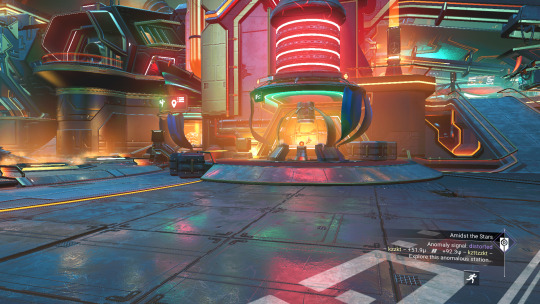
no ones fucking here
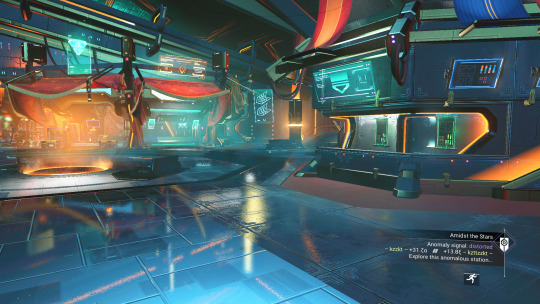
it felt like being in a fucking liminal space
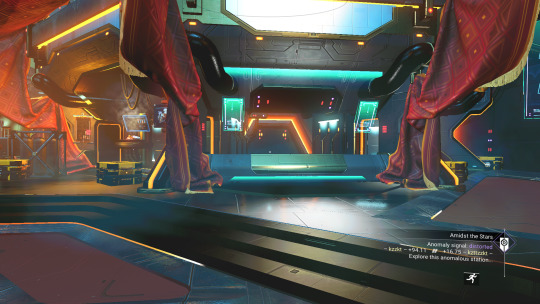
and the game made me look around

see, the npcs aboard the anomaly were characters i knew well and the anomaly is the only constant between all the game modes including expeditions but

see how empty it is....

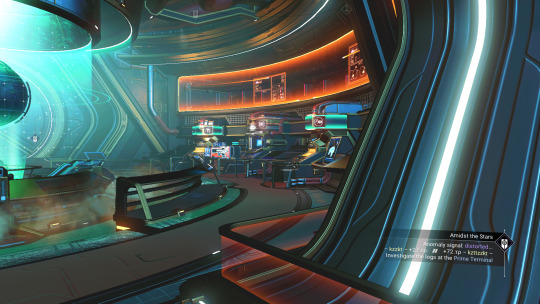
i felt a deep preasure on my chest as i explored
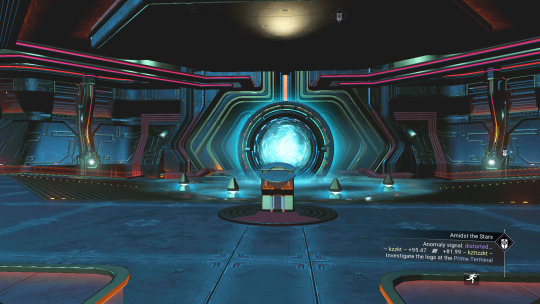
and then i thought to check for polo and nada

the two leaders of the anomaly
they had to be here
atleast nada....
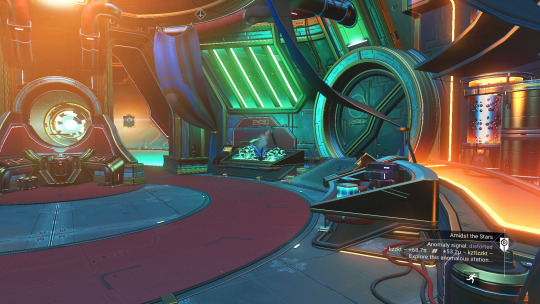
polo wasnt here and...
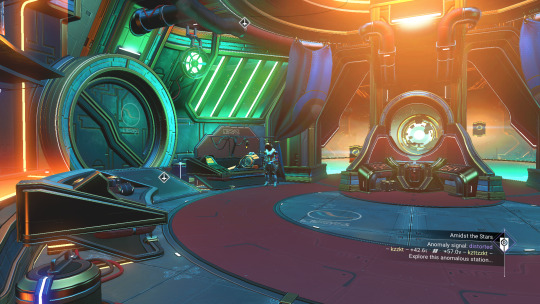



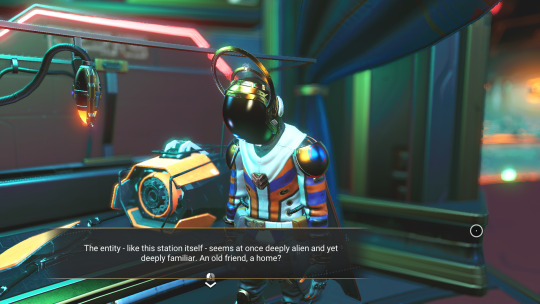
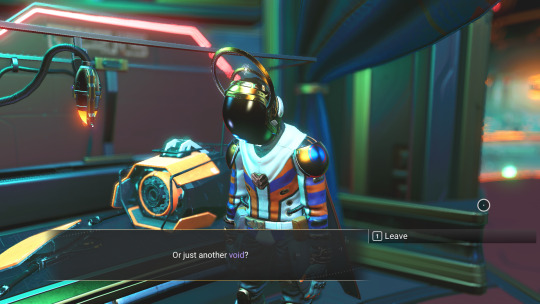
nada was…wasnt here
i got nothing
#no mans sky#holy fuck#i may be easily scared#but fuck man#also sorry for peeps that already know nms lore#spoilers#oh god oh man
19 notes
·
View notes
Note
brothers and/or dateables w/ a ride or die s/c
walmart at 2 am? down. declared the sky is purple? ofc it is what other color could it possibly be man. hit and run? got the Clorox wipes and mechanic on standby
aaaaaa I'm so sorry for the radio silence! Last week was very chaotic lol. This coming week (3/13-3/17) is spring break for me, but I'm working 40 hours so idk how much I'll be active :((.
I had fun writing such a light hearted request, thank u bb.
The Brothers With a Ride or Die MC
GN! MC
Content Warnings: Mentions of doxing in Levi's, mentions of a creep DMing in Asmo's
Lucifer
Lucifer would be so stressed because of a ride or die MC lol. You're giving him even more grey hairs than he needs. He does appreciate all that you do for him, he just wishes you'd take it down a notch.
He could easily tell his brothers to do something like go get dish soap because it's almost out, but you're already out the door with like four different soap brands on the list.
It gives him an extra reason to spoil you though
Mammon
It's basically a ride or die x ride or die in all honesty. A competition to see who can be the most ride or die, if you will.
He forgets to do a project for class until the night before? You're there helping him. You forget a textbook back at the HoL? Don't worry, he's sprinting back to go get it for you.
He accidentally breaks something? You're getting rid of the evidence and already have a duplicate on stand by (how you do it, Mammon will never know).
Leviathan
I feel that Levi would be more of the ride or die in this relationship, but for the sake of the request, you are. Is he in the middle of a gaming marathon? You keep a supply of water and snacks for him. You make sure he actually eats a full meal, too.
He talks about a new multiplayer game? You buy a copy for yourself to practice playing so you can keep up with him.
He want's to dox someone who dissed Ruri-chan? You're already digging for clues
Satan
Satan mentions a new spell book he found? You're the first to volunteer to be a guinea pig for some of the spells. He appreciates the sentiment, but he'd rather not test questionable spells on is lover
He mentions that he needs to organize his books? You're pulling out a pen and paper to create organization categories and schematics (it'll probably go Year, Subject, Author's last name or something similar).
He'll make you tea as a thank you, but he doesn't notice he used a tea that you snuck into his stash as a surprise.
Asmodeus
Another ride or die x ride or die. This time, instead of trying to out do one another, y'all just feed off of eachother's energy.
You're Asmo's hype person. He'll take you shopping with him and try on outfits. You're there with a camera practically like the paparazzi, taking pictures from all angles for every outfit he tries. He does the same for you. There's a 9/10 chance the two of you will leave with matching outfits.
Asmo mentions that some creep is bothering him on Devilgram? You're finding the fucker and giving that demon some very concerning threats.
Beelzebub
We all know how Beel gets with is food. If he texts you that he's hungry, you're on standby with his favorite snacks. Even during class, you'll leave to do a quick drop off for him
Midnight muchies? Take him to the nearest fast food joint and get him two of everything. He appreciates your eagerness to please, but he worries about your spending habits because of him (sweet boy)
He'll share his food with you as a thank you and offer to pay you back for the money you've spent on him. If you tell him that you don't mind, he'll find a way to repay you.
Belphegor
You're able to pick up on some of his smallest ques and you know what to do to help out. He really does appreciate how you're able to pick up on when his social battery is low and get him out of the situation.
He's notorious for skipping class even though he somehow miraculously passes his classes. Still, you bring him your notes and even send him an audio recording of the lectures you share together, even though it takes up so much space on your DDD.
If you notice he has fallen asleep somewhere that isn't his room or your room, you carry a blanket just for him. You drape it over him as he sleeps and just vibe next to him until he wakes up.
#obey me#obey me shall we date#omswd#obey me x reader#lucifer x reader#om! lucifer#mammon x reader#om mammon#leviathan x reader#om! leviathan#satan x reader#om satan#om asmodeus#asmodeus x reader#beelzebub x reader#om! beelzebub#belphegor x reader#om belphegor#obey me imagines#obey me hcs
357 notes
·
View notes
Text
Murf's Polls #1 😈
#simblr#the sims 1#the sims 2#the sims 3#the sims 4#the sims 5#paralives#sims city#let there be sims#i woke up today and chose violence
157 notes
·
View notes
Note
what games do you like
god idk i just play whatever. i play a lot of multiplayer games mostly but i love certain singleplayer games. my most played games on steam are warframe at 1906 hrs and tf2 at 1302 hours. then theres like smite and gmod which i havent played in years, then deep rock galactic, ff14, elden ring, no mans sky, etc. some of the most impactful games for me have been disco elysium, subnautica, no mans sky, gmod, tf2, fallout new vegas, and minecraft (havent touched mc in years either) among others. i like playing with friends, action, loot, exploration, and atmosphere ig?
19 notes
·
View notes
Text
Because of the size of the game's universe, Sean Murray estimated that more than 99.9% of the planets would never be explored by players, and that the chance of meeting other players through chance encounters would be "incredibly slim".
Questions regarding the multiplayer aspects of No Man's Sky were raised a day following the official release on the PlayStation 4. Two players attempted to meet at a location in the game's virtual universe after one player recognised the other upon seeing their username attached to a planetary discovery. Despite confirming they had been at the same spot on the same planet outside of the game through their respective Twitch streams, they could not see each other. Furthering this was the discovery that European copies of the limited edition packaging used a sticker to cover the PEGI online play icon. Hello Games noted that they have had "far more" players than they expected at launch and are bringing on more people to help support the game along with patching the critical issues at the game's launch, but they have not made a direct statement on the multiplayer situation as of September 2016.
According to Murray in 2018, Hello Games had worked to try to keep this light multiplayer element in the game through the final part of their development cycle, but found that it was very difficult to include, and opted to remove it for the game's release, believing that with the size of the game's universe, only a few players would end up experiencing it.
funniest game release evarrrrr
8 notes
·
View notes
Text
Granblue Fantasy: Relink PS5 and PS4 demo launches in January 2024; playable characters Cagliostro, Seofon, and Tweyen announced
Gematsu Source
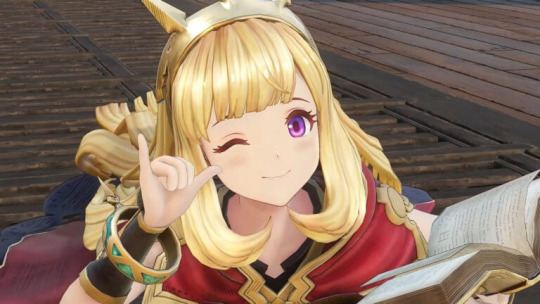
Cagliostro will be a playable character in action RPG Granblue Fantasy: Relink, and Seofon and Tweyen will join the roster as playable characters via a free update in April 2024, publisher Cygames and developer Cygames Osaka announced.
Cygames also revealed the Granblue Fantasy: Relink theme song “Good Night, Good Morning,” which is sung by Nao Toyama, and announced that a free demo will be available for PlayStation 5 and PlayStation 4 in January 2024.
Get the details below.
■ Theme Song
The theme song for Granblue Fantasy: Relink is “Good Night, Good Morning,” sung by Nao Toyama.
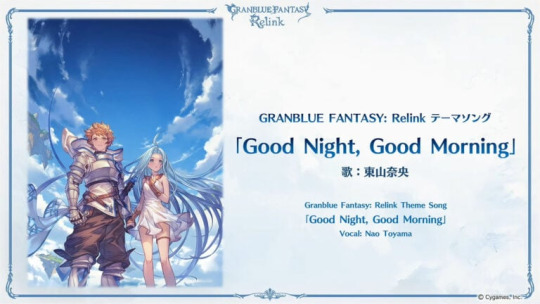
■ Primal Beasts
Primal Beast Managarmr and Primal Beast Furycane
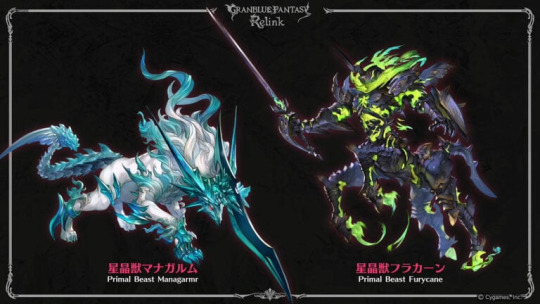
Primal Beast Excavallion and Primal Beast Vulkan Bolla
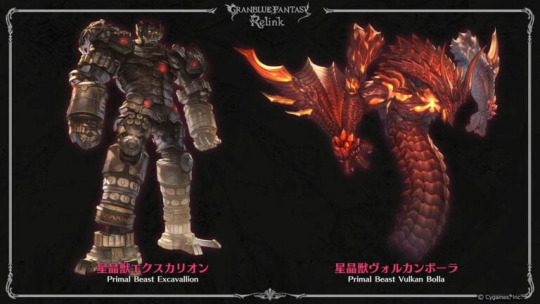
■ Enemy CharactersId and Lilith

Gallanza and Maglielle
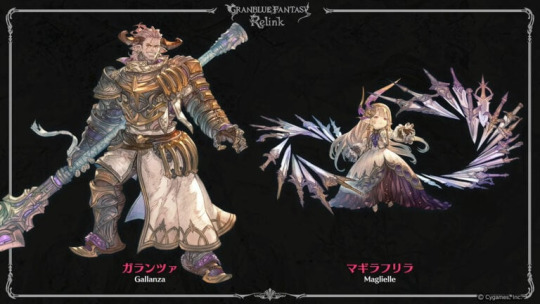
■ Game Overview

Genre: Action RPG
A completely unique action experience for every character!
Can be enjoyed solo or as a multiplayer experience with up to four players.
Coming to PlayStation 5/4 and Steam on February 1, 2024.
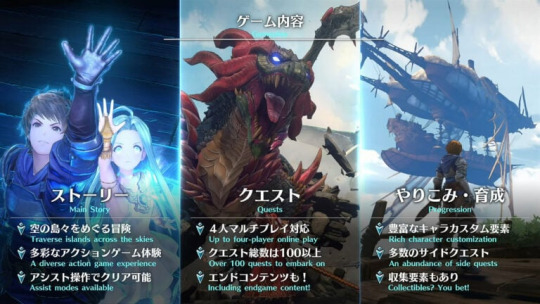
-Main Story
Traverse islands across the skies.
A diverse action game experience.
Assist modes available.
-Quests
Up to four-player online play.
Over 100 quests to embark on.
Including endgame content!
-Progression
Rich character customization.
An abundance of side quests.
Collectibles? You bet!
■ New Character
Cagliostro (voiced by Sarah Anne Williams in English, Sakura Tange in Japanese)

A brilliant mage who founded alchemy in the Sky Realm. She has learned how to achieve virtual immortality by regularly replacing her body with new vessels that suit her tastes.
■ Base Game Roster
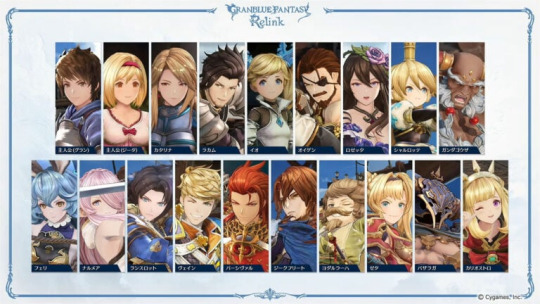
■ Post-Launch Characters (Free Update in April 2024)
Seofon (voiced by Alejandro Saab in English, Junichi Suwabe in Japanese)

This man leads the Eternals, a group of ten weapon masters. Also known as the Star-Sword Sovereign, Seofon collects spirit swords from defeated opponents and channels that spirit energy to manifest them onto the battlefield.
Arriving in an April 2024 update!
Tweyen (voiced by Giselle Fernandez in English, Yuuko Minaguchi in Japanese)
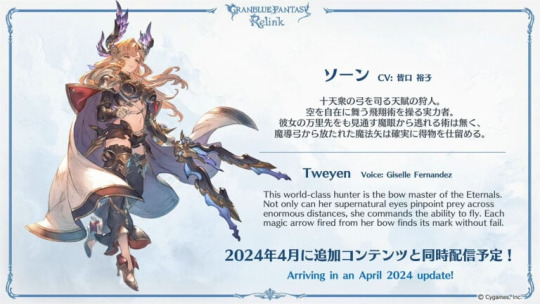
This world-class hunter is the bow master of the Eternals. Not only can her supernatural eyes pinpoint prey across enormous distances, she commands the ability to fly. Each magic arrow fired from her bow finds its mark without fail.
Arriving in an April 2024 update!
■ Free Demo (PlayStation only)
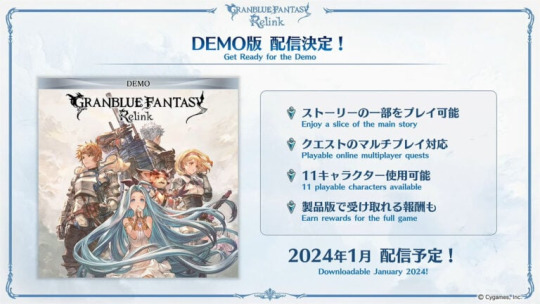
A playable demo of Granblue Fantasy: Relink is coming to PlayStation 5 and PlayStation 4 consoles in January 2024!
Enjoy a slice of the main story.
Playable online multiplayer quests.
11 playable characters available.
Earn rewards for the full game.
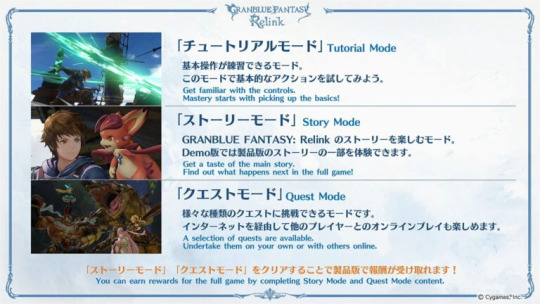
Learn the ropes through the tutorial mode, play a slice of the main story, and embark on multiplayer quests online—all for free!
Tutorial Mode – Get familiar with the controls. Mastery starts with picking up the basics!
Story Mode – Get a taste of the main story. Find out what happens next in the full game!
Quest Mode – A selection of quests are available. Undertake them on your own or with others online.
You can earn rewards for the full game by completing Story Mode and Quest Mode content.
■ Tune In to the Pre-Release Show!
Granblue Fantasy Showcase Part 2: Granblue Fantasy: Relink will premiere on January 11, 2024 at 2:00 a.m. PT / 5:00 a.m. ET / 19:00 JST. Read the full announcement here.
■ Original Soundtrack Details

The Granblue Fantasy: Relink Collector’s Edition is back in stock (Japan only). Pre-order from Cystore or 7net Online Shopping!
Granblue Fantasy: Relink is due out for PlayStation 5, PlayStation 4, and PC via Steam on February 1, 2024.
Watch a new set of trailers below.
Boss Battle Trailer
English
youtube
Japanese
youtube
Theme Song Trailer
English
youtube
Japanese
youtube
Cagliostro Teaser Video
youtube
16 notes
·
View notes
Text
Dragon Age: The Veilguard GameInformer Article Transcribed
I saw some people lamenting that they had no way to read the GameInformer article, and while MVP dalishious posted screenshots of the article here, I figured that might be a little difficult to read, plus people with screen readers can't read it of course. So I've gone ahead and transcribed it! Full thing below the cut!
As a note, I transcribed it without correcting any typos, capitalization errors, etc. that the article itself had (as much as it pained me, omg the author capitalizes so many things that shouldn't be and vice versa). There may be some typos on my part as I did this as quickly as I could, so apologies in advance for any you might encounter.
I have also created a plot-spoiler-free version of the article for those who would like to learn more about the mechanics of the game without learning more plot info than they want!
Throughout my research and preparation for a trip to BioWare’s Edmonton, Canada, office for this cover story, I kept returning to the idea that its next game, Dragon Age: The Veilguard (formerly subtitled Dreadwolf) is releasing at a critical moment for the storied developer. The previous installment, Dragon Age: Inquisition, hit PlayStation, Xbox, and PC a decade ago. It was the win BioWare needed, following the 2012 release of Mass Effect 3 with its highly controversial and (for many) disappointing ending. Inquisition launched two years later, in 2014, to rave reviews and, eventually, various Gameo the Year awards, almost as if a reminder of what the studio was capable of.
Now, in 2024, coincidentally, the next Dragon Age finds itself in a similar position. BioWare attempted a soft reboot of Mass Effect with Andromeda in 2017, largely seen as a letdown among the community, and saw its first live-service multiplayer attempt in 2019’s Anthem flounder in the tricky waters of the genre; it aimed for a No Man’s Sky-like turnaround with Anthem Next, but that rework was canceled in 2021. Like its predecessor, BioWare’s next Dragon Age installment is not only a new release in a beloved franchise, but is another launch with the pressure of BioWare’s prior misses; a game fans hope will remind them the old BioWare is still alive today.
“Having been in this industry for 25 years, you see hits and misses, and it’s all about building off of those hits and learning from those misses,” BioWare general manager Gary McKay, who’s been with the studio since January 2020, tells me.
As McKay gives me a tour of the office, I can’t help but notice how much Anthem is scattered around it. More than Mass Effect, more than Dragon Age, there’s a lot of Anthem - posters, real-life replicas of its various Javelins, wallpaper, and more. Recent BioWare news stories tell of leads and longtime studio veterans laid off and others departing voluntarily. Veilguard’s development practically began with the COVID-19 pandemic in 2020. When I ask McKay about the tumultuousness of BioWare and how he, as the studio manager, makes the team feel safe in the product it’s developing, he says it’s about centering on the creative vision. “[When] we have that relentless pursuit for quality, and we have passion and people in the right roles, a lot of the other stuff you’re talking about just fades into the background.”
That’s a sentiment echoed throughout the team I speak to: Focus on what makes a BioWare game great and let Veilguard speak for itself. Though I had no expectations going in - it’s been 10 years since the last Drag Age, after all, and BioWare has been cagey about showing this game publicly - my expectations have been surpassed. This return to Thedas, the singular continent of the franchise, feels like both a warm welcome for returning fans and an impressive entry point for first-time players.
New Age, New Name
At the start of each interview, I address a dragon-sized elephant in the room with the game’s leads. What was Dragon Age: Dreadwolf is now Dragon Age: The Veilguard. Why?
“These games are reflections of the teams that make them, and as part of that, it means we learn a lot about what the heart and soul of the game really is as we’re developing it,” Veilguard game director Corinne Busche tells me. “We quickly learned and realized that the absolute beating heart of this game is these authentic, diverse companions. And when we took a step back, as we always do, we always check our decisions and make sure they still represent the game we’re trying to build.”
Dreadwolf no longer did that, but each member of BioWare I speak to tells me The Veilguard does. And while I was initially abrasive to the change - lore aside, Dreadwolf is simply a cool name - I warmed up to The Veilguard.
Solas, a Loki-esque trickster member of the Elven pantheon of gods known as the Dread Wolf, created the Veil long ago while attempting to free the elves from their slave-like status in Thedas. This Veil is a barrier between the magical Fade and Thedas, banishing Elven gods and removing Elven immortality from the world. But players didn’t know that in Inquisition, where he is introduced as a mage ally and companion. However, at the end of Inquisition’s Trespasser DLC, which sets the stage for Veilguard, we learn in a shocking twist that Solas wants to destroy the Veil and restore Elves to their former glory. However, doing so would bring chaos to Thedas, and those who call it home, the people who eventually become The Veilguard, want to stop him.
“There’s an analogy I like to use, which is, ‘If you want to carve an elephant out of marble, you just take a piece of marble and remove everything that doesn’t look like an elephant,’” Veilguard creative director John Epler says. “As we were building this game, it became really clear that it was less that we were trying to make The Veilguard and more like The Veilguard was taking shape as we built the game. Solas is still a central figure in it. He’s still a significant character. But really, the focus shifts to the team.
“[We] realized Dreadwolf suggests a title focused on a specific individual, whereas The Veilguard, much like Inquisition, focuses more on the team.”
Creating Your Rook
Veilguard’s character creator is staggeringly rich, with a dizzying number of customizable options. Busche tells me that inclusivity is at the heart of it, noting that she believes everyone can create someone who represents them on-screen.
There are four races to choose from when customizing Rook, the new playable lead - Elves, Qunari, Humans, and Dwarves - and hundreds of options to customize your character beyond that. You can select pronouns separately from gender and adjust physical characteristics like height, shoulder width, chest size, glute and bulge size, hip width, how bloodshot your eyes are, how crooked your nose is, and so much more. There must be hundreds of sliders to customize these body proportions and features like skin hue, tone, melanin, and just about anything else you might adjust on a character. Oh, and there’s nudity in Veilguard, too, which I learn firsthand while customizing my Rook.
“The technology has finally caught up to our ambition,” Dragon Age series art director Matt Rhodes tells me as we decide on my warrior-class Qunari’s backstory, which affects faction allegiance, in-game dialogue, and reputation standing - we choose the pirate-themed Lords of Fortune.
Notably, instead of a warrior class, we could have chosen mage or rogue. All three classes have unique specializations, bespoke skill trees, and special armors, too. And though our Rook is aligned with the Lords of Fortune faction, there are others to choose from including the Grey Wardens, Shadow Dragons, The Mourn Watch, and more. There is some flexibility in playstyle thanks to specializations, but your class largely determines the kind of actions you can perform in combat.
“Rook ascends because of competency, not because of a magical McGuffin,” BioWare core lead and Mass effect executive producer Michael Gamble tells me in contrast to Inquisition’s destiny-has-chosen-you-characterization.
“Rook is here because they choose to be, and that speaks to the kind of character that we’ve built.” Busche adds, “Someone needs to stop this, and Rook says, ‘I guess that’s me.’”
Beyond the on-paper greatness of this character creator, its customizability speaks to something repeated throughout my BioWare visit: Veilguard is a single-player, story-driven RPG. Or in other words, the type of game that made BioWare as storied as it is. McKay tells me the team explored a multiplayer concept early in development before scratching it to get back to BioWare basics. The final game will feature zero multiplayer and no microtransactions.
Happy to hear that, I pick our first and last name, then one of four voices, with a pitch shifter for each, too, and we’re off to Minrathous.
Exploring Tevinter For The First Time
Throughout the Dragon Age series, parts of Thedas are discussed by characters and referenced by lore material but left to the imagination of players as they can’t visit them. Veilguard immediately eschews this, setting its opening prologue mission in Minrathous, the capital of the Tevinter Empire. Frankly, I’m blown away by how good it looks. It’s my first time seeing Veilguard in action and my first look at a Dragon Age game in nearly a decade. Time has treated this series well, and so has technology.
Epler, who’s coming up on 17 years at BioWare, acknowledges that the franchise has always been at the will of its engine. Dragon Age: Origins and II’s Eclipse Engine worked well for the time, but today, they show their age. Inquisition was BioWare’s first go at Ea’s proprietary Frostbite engine - mind you, an engine designed for first-person shooters and decidedly not multi-character RPGs - and the team struggled there, too. Epler and Busche agree Veilguard is the first RPG where BioWare feels fully in command of Frostbite and, more generally, its vision for this world.
We begin inside a bar. Rook and Varric are looking for Neve Gallus, a detective mage somewhere in Minrathous. The first thing players will do once Veilguard begins is select a dialogue option, something the team says speaks to their vision of a story-forward, choice-driven adventure. After a quick bar brawl cutscene that demonstrates Rook’s capabilities, there’s another dialogue choice, and different symbols here indicate the type of tone you can roll with. There’s a friendly, snarky, and rough-and-tough direct choice, and I later learn of a more romantically inclined “emotional” response. These are the replies that will build relationships with characters, romantic and platonic alike, but you’re welcome to ignore this option. However, your companions can romance each other, so giving someone the cold shoulder might nudge them into the warm embrace of another. We learn Neve is in Dumat Plaza and head into the heart of Minrathous.
Rhodes explains BioWare’s philosophy for designing this city harkens back to a quick dialogue from Inquisition’s Dorian Pavus. Upon entering Halamshiral’s Winter Palace, the largest venue in Dragon Age history at that point, Dorian notes that it’s cute, adorable even, alluding to his Tevinter heritage. If Dorian thinks the largest venue in Dragon Age history is cute and adorable, what must the place he’s from be like? “It’s like this,” Rhodes says as we enter Minrathous proper in-game.
Minrathous is huge, painted in magical insignia that looks like cyberpunk-inspired neon city signs and brimming with detail. Knowing it’s a city run by mages and built entirely upon magic, Rhodes says the team let its imagination run wild. The result is the most stunning and unique city in the series. Down a wide, winding pathway, there’s a pub with a dozen NPCs - Busche says BioWare used Veilguard’s character creator to make each in-world NPC except for specific characters like recruitable companions - and a smart use of verticality, scaling, and wayfinding to push us toward the main attraction: Solas, attempting to tear down the Veil.
All hell is breaking loose. Pride Demons are rampaging through the city. Considering Pride Demons were bosses in prior games, seeing them roaming freely in the prologue of Veilguard speaks to the stakes of this opener. Something I appreciate throughout our short journey through Minrathous to its center below is the cinematography at play. As a Qunari, my character stands tall, and Rhodes says the camera adjusts to ensure larger characters loom over those below. On the flip side, the camera adjusts for dwarves to demonstrate their smaller stature compared to those around them.
This, coupled with movie-liked movement through the city as BioWare showcases the chaos happening at the hands of Solas’ Veil-break ritual, creates a cinematic start that excited me, and I’m not even hands-on with the game.
Eventually, we reach Neve, who has angered some murderous blood mages, and rescue her from danger. Or rather, help… barely. Neve is quite capable, and her well-acted dialogue highlights that. Together, Varric, returning character Lace Harding, who is helping us stop Solas and is now a companion, Rook, and Neve defeat some demons. They then take on some Venatori Cultists seizing this chaotic opportunity to take over the city and other enemies before making it to Solas’ hideout. As we traverse deeper and deeper into this hideout, more of Solas’ murals appear on the walls, and things get more Elven. Rhodes says this is because you’re symbolically going back in time, as Minrathous is a city built by mages on the bones of what was originally the home of Elves.
At the heart of his hideout, we discover Solas’ personal Eluvian. This magical mirror-like structure allows the gang to teleport (and mechanically fast-travel) to Arlathan Forest, where Solas is secretly performing the ritual (while its effects pour out into Minrathous).
Here, we encounter a dozen or so demons, which BioWare has fully redesigned on the original premise of these monstrous creatures. Rhodes says they’re creatures of feeling and live and die off the emotions around them. As such, they are just a floating nervous system, push into this world from the Fade, rapidly assembled into bodies out of whatever scraps they find.
I won’t spoil the sequence of events here, but we stop Solas’ ritual and seemingly save the world… for now. Rook passes out moments later and wakes up in a dream-like landscape to the voice of none other than Solas. He explains a few drops of Rook’s blood interacted with the ritual, connecting them to the Fade forever. He also says he was attempting to move the Elgar’nan and Ghilan’nain, part of the Evanuris or Elven gods of ancient times, to a new prison because the one he had previously constructed was failing. Unfortunately, Solas is trapped in the Fade by our doing, and these gods are now free. It’s up to Rook to stop them; thus, the stage for our adventure is set.
The Veilguard Who’s Who
While we learned a lot about returning character but first-time companion Lace Harding, ice mage private detective Neve Gallus, and veil jumper Bellara Lutara, BioWare shared some additional details about other companions Rook will meet later in the game. Davrin is a charming Grey Warden who is also an excellent monster hunter; Emmrich is a member of Nevarra’s Mourn Watch and a necromancer with a skeleton assistant named Manfred; Lucanis is a pragmatic assassin whose bloodline descends from the criminal House of Crows organization; And Taash is a dragon hunter allied with the piratic Lords of Fortune. All seven of these characters adorn this Game Informer issue, with Bellara up front and center in the spotlight.
The Lighthouse
After their encounter with Solas, Rook wakes up with Harding and Neve in the lair of the Dread Wolf himself, a special magical realm in the Fade called the Lighthouse. It’s a towering structure centered amongst various floating islands. Epler says, much like Skyhold in Inquisition, the Lighthouse is where your team bonds, grows, and prepares for its adventures throughout the campaign. It also becomes more functional and homier as you do. Already, though, it’s a beautifully distraught headquarters for the Veilguard, although they aren’t quite referring to themselves as that just yet.
Because it was Solas’ home base of operations, it’s gaudy, with his fresco murals adorning various walls, greenery hanging from above, and hues of purple and touches of gold everywhere. Since it’s in the Fade, a realm of dreams that responds to your world state and emotion, the Lighthouse reflects the chaos and disrepair of the Thedas you were in moments ago. I see a clock symbol over a dialogue icon in the distance, which signals an optional dialogue option. We head there, talk to Neve, select a response to try our hand at flirting, and then head to the dining hall.
A plate, a fork and knife, and a drinking chalice are at the end of a massive table. Rhodes says this is both a funny (and sad) look at Solas’ isolated existence and an example of the detail BioWare’s art team has put into Veilguard. “It’s a case of letting you see the story,” he says. “It’s like when you go to a friend's house and see their bedroom for the first time; you get to learn more about them.” From the dining hall, we gather the not-quite-Veilguard in the library, which Busche says in the central area of the Lighthouse and where your party will often regroup and prepare for what’s next. The team decides it must reach the ritual site back in Arlathan Forest, and Busche says I’m missing unique dialogue options here because I’m Qunari; an Elf would have more to say about the Fade due to their connection to it. The same goes for my backstory earlier in Minrathous. If I had picked the Shadow Dragons background, Neve would have recognized me immediately, with unique dialogue.
With our next move decided, we head to Solas’ Eluvian to return to Arlathan Forest and the ritual site. However, it’s not fully functional without Solas, and while it returns us to Arlathan Forest, it’s not exactly where we want to go. A few moments later, we’re back in the Arlathan Forest, and just before a demon-infested suit of mechanized armor known as a Sentinel can attack, two new NPCs appear to save us: Strife and Irelin. Harding recognizes them, something Dragon Age comic readers might know about. They’re experts in ancient elven magic and part of the new Veil Jumpers faction. The ensuing cutscene, where we learn Strife and Irelin need help finding someone named Bellara Lutara, is long, with multiple dialogue options. That’s something I’m noticing with Veilguard, too - there’s a heavy emphasis on storytelling and dialogue, and it feels deep and meaty, like a good fantasy novel. BioWare doesn’t shy away from minutes-long cutscenes.
Busche says that’s intentional, too. “For Rook, [this story’s about] what does it meant to be a leader,” she says. “You’re defining their leadership style with your choices.” Knowing that Rook is the leader of the Veilguard, I’m excited to see how far this goes. From the sound of it, my team will react to my chosen leadership style in how my relationships play out. That’s demonstrated within the game’s dialogue and a special relationship meter on each companion’s character screen.
Redefining Combat Once More
Bellara is deep within Arlathan Forest, and following the prolgoue’s events, something is up here. Three rings of massive rocks fly through the air, protecting what appears to be a central fortress. Demon Sentinels plague the surrounding lands, and after loading up a new save, we’re in control of a human mage.
Following the trend of prior Dragon Age games, Veilguard has completed the series’ shift from tactical strategy to real-time action, but fret not: a tactical pause-and-play mechanic returns to satiate fans who remember the series’ origins (pun intended). Though I got a taste of combat in the prologue, Veilguard’s drastic departure from all that came before it is even more apparent here.
Busche says player complete every swing in real-time, with special care taken to animation swing-through and canceling. There's a dash, a parry, the ability to charge moves, and a completely revamped healing system that allows you to use potions at your discretion by hitting right on the d-pad. You can combo attacks and even “bookmark” combos with a quick dash, which means you can pause a combo’s status with a dash to safety and continue the rest of the combo afterward. It looks even cooler than it sounds.
Like any good action game, there is a handful of abilities to customize your kit. And, if you want to maintain that real-time action feel, you can use them on the fly, so long as you take cooldowns into effect. But Veilguard’s pause-and-play gameplay mechanic, similar to Inquisition’s without the floating camera view, lets you bring things to halt for a healthy but optional dose of strategy.
In this screen, which essentially pauses the camera and pulls up a flashy combat wheel that highlights you and your companions’ skills, you can choose abilities, queue them up, and strategize with synergies and combos, all while targeting specific enemies. Do what you need to here, let go of the combat wheel, and watch your selections play out. Busche says she uses the combat wheel to dole out her companions’ attacks and abilities while sticking to the real-time action for her player-controlled Rook. On the other hand, Epler says he almost exclusively uses the combat wheel to dish out every ability and combo.
Busche says each character will play the same, in that you execute light and heavy attacks with hte same buttons, use abilities with the same buttons, and interact with the combo wheel in the same way, regardless of which class you select. But a sword-and-shield warrior, like we used in the prolgoue, can hip-fire or aim their shield to throw it like Captain America, whereas our human mage uses that same button to throw out magical ranged attacks. The warrior can parry incoming attacks, which can stagger enemies. The rogue gets a larger parry window. Our mage, however, can’t parry at all. Instead, they throw up a shield that blocks incoming attacks automatically so long as you have the mana to sustain it.
“What I see from Veilguard is a game that finally bridges the gap,” former Dragon Age executive producer Mark Darrah, who left BioWare in 2021 before joining the Veilguard team last year as a consultant, tells me. “Uncharitably, previous Dragon Age games got to the realm of ‘combat wasn’t too bad.’ In this game, the combat’s actually fun, but it does keep that thread that’s always been there. You have the focus on Rook, on your character, but still have that control and character coming into the combat experience from the other people in the party.”
“This is really the best Dragon Age game that I’ve ever played,” he adds, noting his bias. “This is the one where we get back to our roots of character-driven storytelling, have really fun combat, and aren’t making compromises.”
Watching Busche take down sentinels and legions of darkspawn on-screen, I can already sense Veilguard’s combat will likely end up my favorite in the series, although admittedly, as a fan of action games, I’m an easy sell here. It’s flashy, quick, and thanks to different types of health bars, like a greenish-blue one that represents barrier and is taken down most effectively with ranged attacks, a decent amount of strategy, even if you don’t use the pause-and-play combo wheel. Like the rest of the game, too, it’s gorgeous, with sprinkles, droplets, and splashes of magic in each attack our mage unleashes. Though I’m seeing the game run on a powerful PC, which is sure to be the best showcase of Veilguard, Epler tells me the game looks amazing on consoles - he’s been playing it on PlayStation 5 and enjoying it in both its fidelity and performance modes, but I’ll have to take his word for it.
Pressing Start
The start or pause screen is as important to a good RPG as the game outside the menus. Veilguard’s contains your map, journal, character sheets, skill tree, and a library for lore information. You can cross-compare equipment and equip new gear here for Rook and your companions, build weapon loadouts for quick change-ups mid-combat, and customize you and your party’s abilities and builds via an easy-to-understand skill tree. You won’t find minutiae here, “just real numbers,” Busche says. That means a new unlocked trait might increase damage by 25 percent against armor, but that’s as in-depth as the numbers get. Passive abilities unlock jump attacks and guarantee critical hit opportunities, while abilities add moves like a Wall of Fire to your arsenal (if you’re a mage). As you spec out this skill tree, which is 100 percent bespoke to each class, you’ll work closer to unlocking a specialization, of which there are three for each class, complete with a unique ultimate ability. Busche says BioWare’s philosophy here is “about changing the way you play, not statistical minutiae.”
Companion Customization
You can advance your bonds by helping companions on their own personal quests and by including them in your party for main quests. Every Relationship Level you rank up, shown on their character sheet, nets you a skill point to spend on them. Busche says the choices you make, what you say to companions, how you help them, and more all matter to their development as characters and party members. And with seven companions, there’s plenty to customize, from bespoke gear to abilities and more. Though each companion has access to five abilities, you can only take three into combat, so it’s important to strategize different combos and synergies within your party. Rhodes says beyond this kind of customizable characterization, each companion has issues, problems, and personal quests to complete. “Bellara has her own story arc that runs parallel to and informs the story path you’re on,” Rhodes says.
In Entropy’s Grasp
As we progress through the forest and the current “In Entropy’s Grasp” mission, we finally find Bellara. She’s a veil jumper, the first companion you meet and recruit in-game (unlike Neve, who automatically joins), and the centerpiece of this issue’s cover image. Because our mage’s background is Veil Jumper, we get some unique dialogue. Bellara explains we’re all trapped in a Veil Bubble, and there’s no way out once you pass through it. Despite the dire situation, Bellara is bubbly, witty, and charming.
“When designing companions, they’re the load-bearing pillars for everything,” Rhodes says. “They’re the face of their faction, and in this case [with Bellara], their entire area of the world. She’s your window into Arlathan Forest.” Rhodes describes her as a sweetheart and nerd for ancient elven artifacts. As such ,she’s dressed more like an academic than a combat expert, although her special arm gauntlet is useful both for tinkering with her environment and taking down enemies.
Unlike Neve, who uses ice magic like our Rook and can slow down time with a special ability, Bellara specializes in electricity, and she can also use magic to heal you, something Busche says Dragon Age fans have been desperate to have in a game. Busche says if you don’t direct Neve and Bellara, they’re fully independent and will attack on their own. But synergizing your team will add to the fun and strategy of combat. Bellara’s electric magic is effective against Sentinels, which is great because we currently only have access to ice. However, without Bellara, we could also equip a rune that converts my ice magic, for a brief duration, into electricity to counter the Sentinels.
As we progress through Arlathan Forest, we encounter more and more darkspawn. Bellara mentions the darkspawn have never been this far before because the underground Deep Roads, where they usually escape from, aren’t nearby. However, with blighted Elven gods roaming the world, and thanks to Blight’s radiation-like spread, it’s a much bigger threat in Veilguard than in any Dragon Age before it.
I continue to soak in the visuals of Veilguard with Arlathan Forest’s elven ruins, dense greenery, and disgusting Blight tentacles and pustules; it’s perhaps the most impressive aspect of my time seeing the game, although everything else is making a strong impression, too. I am frustrated about having to watch the game rather than play it, to be honest. I’m in love with the art style, which is more high fantasy than anything in the series thus far and almost reminiscent of the whimsy of Fable, a welcome reprieve from the recent gritty Game of Thrones trend in fantasy games. Rhodes says that’s the result of the game’s newfound dose of magic.
“The use of magic has been an evolution as the series has gone on,” he says. “It’s something we’ve been planning for a while because Solas has been planning all this for a while. In the past, you could hint at cooler magical things in the corner because you couldn’t actually go there, but now we actually can, and it’s fun to showcase that.”
Busche, Epler, and Rhodes warn me that Arlathan Forest’s whimsy will starkly contrast to other areas. They promise some grim locations and even grimmer story moments because, without that contrast, everything falls flat. Busche likens it to a “thread of optimism” pulled through otherworldly chaos ravaging Thedas. For now, the spunky and effervescent Bellara is that thread.
As we progress deeper into the forest, Bellara spots a floating fortress and thinks the artifact needed to destroy the Veil Bubble is in there. To reach it, though, wem ust remove the floating rock rings, and Bellara’s unique ability, Tinker, can do just that by interacting with a piece of ancient elven technology nearby. Busche says Rook can acquire abilities like Tinker later to complete such tasks in instances where Bellara, for example, isn’t in the party.
Bellara must activate three of these in Arlathan Forest to reach the floating castle, and each one we activate brings forth a slew of sentinels, demons, and darkspawn to defeat. Busche does so with ease, showcasing high-level gameplay by adding three stacks of arcane build-up to create an Arcane Bomb on an enemy, which does devastating damage after being hit by a heavy attack. Now, she begins charging a heavy attack on her magical staff, then switches to magical daggers in a second loadout accessed with a quick tap of down on the d-pad to unleash some quick attacks, then back to the staff to charge it some more and unleash a heavy attack.
After a few more combat encounters, including one against a sentinel that’s “Frenzied,” which means it hits harder, moves faster, and has more health, we finally reach the center of the temple. Within is a particular artifact known as the Nadas Dirthalen, which Bellara says means “the inevitability of knowledge.” Before we can advance with it, a darkspawn Ogre boss attacks. It hits hard, has plenty of unblockable, red-coded attacks, and a massive shield we must take down first. However, it’s weak to fire, and our new fire staff is perfect for the situation.
After taking down this boss in a climactic arena fight, Bellara uses a special crystal to power the artifact and remove it from a pedestal, destroying the Veil Bubble. Then, the Nadas Dirthalen comes alive as an Archive Spirit, but because the crystal used to power it breaks, we learn little about this spirit before it disappears. Fortunately, Bellara thinks she can fix it - fixing broken stuff is kind of her thing, Epler says - so the group heads back to the Veil Jumper camp and, as interested as I am in learning what happens next, the demo ends. It’s clear that even after a few hours with the game’s opening, I’ve seen a nigh negligible amount of game; frustrating but equally as exciting.
Don’t Call It An Open World
Veilguard is not an open world, even if some of its explorable areas might fee like one. Gamble describes Veilguard’s Thedas as a hub-and-spoke design where “the needs of the story are served by the level design.” A version of Inquisition’s Crossroads, a network of teleporting Eluvians, returns, and it’s how players will traverse across northern Thedas. Instead of a connected open world, players will travel from Eluvian to Eluvian to different stretches of this part of the continent. This allows BioWare to go from places like Minrathous to tropical beaches to Arlathan Forest to grim and gothic areas and elsewhere. Some of these areas are larger and full of secrets and treasures. Others are smaller and more focused on linear storytelling. Arlathan Forest is an example of this, but there are still optional paths and offshoots to explore for loot, healing potion refreshes, and other things. There’s a minimap in each location, though linear levels like “In Entropy’s Grasp” won’t have the fog of war that disappears as you explore like some of Veilguard’s bigger locations. Regardless, BioWare says Veilguard has the largest number of diverse biomes in series history.
Dragon’s Delight
With a 10-hour day at BioWare behind me after hours of demo gameplay and interviews with the leads, I’m acutely aware of my favorite part of video games: the surprises. I dabbled with Origins and II and put nearly 50 hours into Inquisition, but any familiarity with the series the latter gave me had long since subsided over the past decade. I wanted to be excited about the next Dragon Age as I viewed each teaser and trailer, but other than seeing the words “Dragon Age,” I felt little. Without gameplay, without a proper look at the actual game we’ll all be playing this fall, I struggled to remember why Inquisition sucked me in 10 years ago.
This trip reminded me.
Dragon Age, much like the Thedas of Veilguard, lives in the uncertainty: The turbulence of BioWare’s recent release history and the lessons learned from it, the drastic changes to each Dragon Age’s combat, the mystery of its narrative, and the implications of its lore. It’s all a part of the wider Dragon Age story and why this studio keeps returning to this world. It’s been a fertile franchise for experimentation. While Veilguard is attempting to branch out in unique ways, it feels less like new soil and more like the harvest BioWare has been trying to cultivate since 2009, and I’m surprised by that.
I’m additionally surprised, in retrospect, how numb I’ve been to the game before this. I’m surprised by BioWare’s command over EA’s notoriously difficult Frostbite engine to create its prettiest game yet. I’m surprised by this series’ 15-year transition from tactical strategy to action-forward combat. I’m surprised by how much narrative thought the team has poured into these characters, even for BioWare. Perhaps having no expectations will do that to you. But most of all, with proper acknowledgement that I reserve additional judgment until I actually play the game, I’m surprised that Veilguard might just be the RPG I’m looking forward to most this year.
55 notes
·
View notes